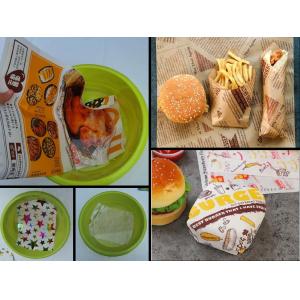

Add to Cart
Disposable Packaging And Table Mat Made Of Stone Paper Waterproof
Moistureproof Oil Resistant Mud Proof Wood Pulp Free
Stone paper is made using calcium carbonate, a compound found in
rocks, and bio-resin. The two materials are combined to form a
non-toxic and recyclable material that has the texture and look of
regular paper. The production process involves crushing the calcium
carbonate into powder, melting the resin, combining the two
ingredients together and then cooling them. Once cooled, the
mixture is extruded through rollers which form sheets of stone
paper. The sheets are then cut into desired sizes for use as
stationery items such as notebooks or cards.
Item | Disposable Packaging And Table Mat Made Of Stone Paper Waterproof
Moistureproof Oil Resistant Mud Proof Wood Pulp Free |
Material | SPN STONE PAPER 80/90/100gsm |
Color | Custom Color |
Size | Custom Size |
Printing | Offset Printing |
Sample Time | 5-7 days |
Lead Time | 7-15 days |
MOQ | 10000pcs, smaller quantity negotiable |
Applications | FOOD PACKAGING, FLOWER PACKAGING, GIFT PACKAGING AND DISPOSABLE
PACKAGING |
Stone Paper has a direct influence on the environment. Replacing
regular paper by Stone Paper results in a significant decrease in
environmental impact. CO2 exhaustion is dramatically lower and
above all, the production process is very clean. No water is used,
no bleach or chemical solutions and of course not a single tree is
felled.
We compared the sustainability of Stone Paper vs regular paper
Cradle-to-gate: we took in account all CO₂-exhaustion as a result
of: attaining, processing and transporting of raw materials;
producing the paper; transport from the factory, and intermediate
storage, to the client. Stone Paper produces 474 kg CO2 per ton
compared to 1.431 kg CO2 per ton for pulp paper.
Raw materials and their impact on the environment
Stone Paper: Calciumcarbonate (80%), originating from waste
material from stone quarries, completely recyclable,
recycle-percentage 58%. Recycled HDPE (20%), completely recyclable,
recycle-percentage 27% Pulp paper: wood pulp is produced from wood,
for this 18 trees are required, wood pulp can be recycled up to 8
times max, recycle-percentage 69%, 92% of forests for
pulp-production has a certificate for sustainable forestation.
Comparison: Stone Paper is produced entirely from recycled waste
material and has a minimal impact on the environment, all the while
18 trees are required to be chopped down to produce 1.000 kg of
pulp paper, which can only be replaced after slowly growing them
back. Pulp paper has a higher recycling percentage than Stone
Paper, but can only be recycled up to 8 times.
Water consumption during production
Stone Paper: the production process is free from water consumption:
0 liter water per 1.000 kg Pulp paper: during production 35.000
liter of water is used, of this 2.770 liter per 1.000 kg pulp paper
is consumed and the rest is re-used later.
Comparison: By choosing for 1.000 kg of Stone Paper over 1.000 kg
of pulp paper the consumption of 2.770 liter of water is prevented.
This is equal to the drink water consumption (coffee, tea, glass of
water, etc.) of an average person over the course of more than 50
months.
Waste that is not re-used during the production process
Stone Paper: no waste during the production process: 0 kg waste per
1.000 kg Pulp paper: almost no waste during the production process:
15 kg waste per 1.000 kg.
Comparison: Both types of paper have a very low waste percentage.
Stone Paper scores slightly better on this area than pulp paper.
Recycle Ways of Stone Paper
The stone paper is made of plastic and inorganic mineral powder,
therefore the recycling way is the second type of recycling. What’s
more, recycled stone paper can be broken into grain which can be
added for producing plastic products. The environmental labeling
is:
Cradle-to-cradle design (also referred to as Cradle to Cradle, C2C,
cradle 2 cradle, or regenerative design) is a biomimetic approach
to the design of products and systems that models human industry on
nature's processes viewing materials as nutrients circulating in
healthy, safe metabolisms. The term itself is a play on the popular
corporate phrase "Cradle to Grave," implying that the C2C model is
sustainable and considerate of life and future generations (i.e.
from the birth, or "cradle," of one generation to the next versus
from birth to death, or "grave," within the same generation.)
(1) Recycling to wood pulp paper recycling plant, Put it into
dissolving pulp pool then fish up as disposal.
(2) Light degradation can still be conducted for stone paper
without crimson solution agent during the production. And the
reasons are as follows: on the one hand, micron-sized stone powder
easily absords heat and gets temperature raised under the sunshine,
which damages adhesives (plastic cement ) by generating steam and
carbon dioxide. On the other hand, the ultraviolet light breaks the
molecular bonds and then leads to the structure fracture of
adhesives(plastic cement ). Our company put the 200μm stone paper
under the sun for 6 months, and the final result was that the stone
paper was broken naturally like a eggshell. Besides, we arranged
solar simulator ultraviolet irradiation tests with 200μm stone
paper, and the test result was also similar to actual sun exposure
experiment.
(3) Landfilled
(4) Be sent to incinerators burning
